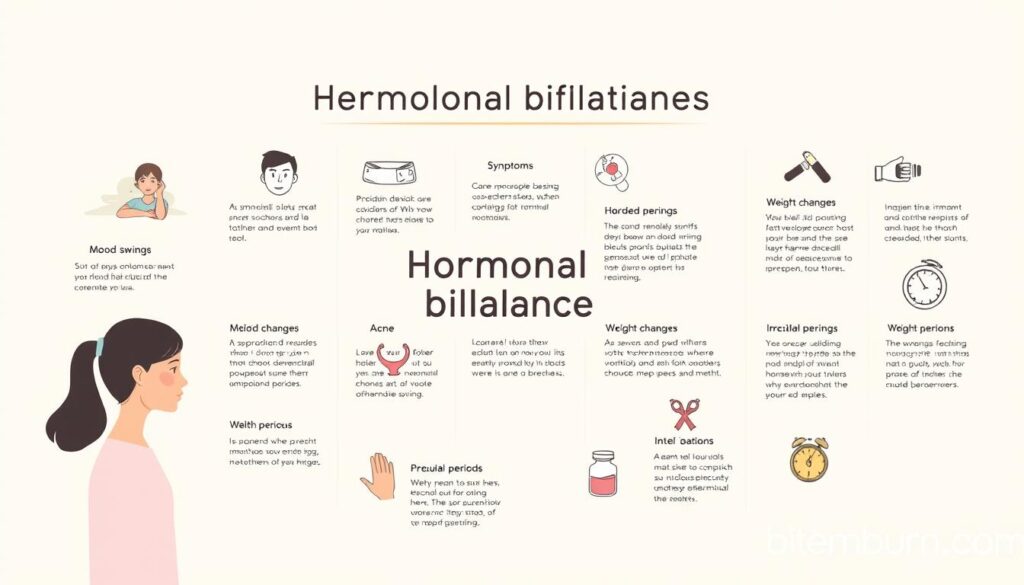Starting to fix hormonal imbalances in 3 weeks is here. Millions face symptoms like fatigue, mood swings, and weight gain without knowing why. Imagine feeling energized, balanced, and in control.
This guide offers a 3-week plan backed by science to bring back harmony. Over 25% of Americans deal with hormonal issues, but many don’t get diagnosed. This guide turns confusion into clear steps to get your health back.
Learn how small changes in diet, sleep, and stress can quickly reset your hormones. Whether it’s PMS, thyroid problems, or unexpected weight changes, this guide simplifies the science. No more guessing—this plan uses research from top health groups with easy steps for everyone.
Key Takeaways
- Identify signs of hormonal imbalances through early symptom recognition.
- Learn a 3-week protocol scientifically designed to address hormonal imbalance symptoms.
- Explore natural remedies and lifestyle changes backed by medical research.
- Understand how diet, sleep, and stress directly impact hormone levels.
- Track progress with clear milestones and expert-backed strategies.
Table of Contents
- Understanding Hormonal Imbalances: The Silent Health Disruptor
- Signs of Hormonal Imbalances and How to Fix It in 3 Weeks: The Complete Guide
- Common Triggers Behind Your Hormonal Chaos
- Hormonal Imbalance in Women: Unique Challenges and Solutions
- Hormonal Imbalance in Men: Breaking the Silence
- The Revolutionary 3-Week Protocol to Restore Hormonal Harmony
- Powerful Natural Remedies and Supplements for Hormone Regulation
- Hormone-Balancing Diet: Foods That Heal vs. Foods That Harm
- Conclusion: Your Journey to Hormonal Balance Starts Today
Understanding Hormonal Imbalances: The Silent Health Disruptor
Hormones are like messengers in your body. They control things like how you feel and how you grow. When they’re not balanced, you might feel tired or gain weight. Knowing about hormonal imbalance causes and how to fix hormonal imbalances starts with understanding their role.
What Are Hormones and Why They Matter
Hormones are divided into types like steroid (cortisol) and peptide (insulin). They work like tiny switches: “Too much or too little can flip health into chaos,” says Dr. Jane Smith, an endocrinologist. These molecules control growth, sleep, and reproduction. For example, estrogen and testosterone shape reproductive health, while cortisol manages stress.
How Hormonal Systems Work Together
Think of hormones as an orchestra. The hypothalamus is the conductor, signaling the pituitary gland. This master gland then tells ovaries, thyroid, and adrenals what to do. Disruptions here—like a missed cue—trigger chain reactions. For instance, low thyroid hormones can slow metabolism, causing weight gain and fatigue.
The Prevalence of Hormonal Imbalances in America
Over 85 million Americans experience hormonal issues yearly, per the CDC. Yet 40% go undiagnosed because symptoms like fatigue are often overlooked.
Women face higher rates of thyroid disorders and PCOS, while men struggle with testosterone drops. Many mistake symptoms for aging, delaying help. But early action—like the signs of hormonal imbalances and how to fix it in 3 weeks guide—can prevent long-term damage. By grasping these basics, you’re one step closer to reclaiming balance.
Signs of Hormonal Imbalances and How to Fix It in 3 Weeks: The Complete Guide

Spotting signs of hormonal imbalances early can change your health journey. Common hormonal imbalance symptoms vary but often include:
| Symptom | Possible Hormonal Cause | Quick Fix Tip |
|---|---|---|
| Irregular periods | Estrogen/Progesterone imbalance | Track cycles with apps like Clue |
| Fatigue | Cortisol dysregulation | Try 10-minute morning meditation |
| Unexplained weight changes | Thyroid dysfunction | Swap processed snacks for protein-rich meals |
| Mood swings | Low serotonin/Dopamine | Journal emotions daily to identify patterns |
| Acne outbreaks | High androgen levels | Cleanse skin with salicylic acid |
Subtle symptoms like brain fog or digestive issues? These could signal insulin resistance or adrenal fatigue. Don’t ignore “minor” signs—your body’s clues matter. The 3-week plan in later sections addresses each symptom through diet, sleep, and stress management. Keep this guide handy to match your symptoms with actionable steps. Small changes now set the stage for lasting balance.
Common Triggers Behind Your Hormonal Chaos
Understanding what causes hormonal imbalances starts with everyday triggers. From chemicals in products to daily habits, small changes can make a big difference. Let’s explore four key areas disrupting your body’s natural balance.
Environmental Factors Affecting Hormone Production
Hidden toxins in everyday items act like impostors in your body. Plastics, cosmetics, and cleaning products often contain endocrine disruptors like BPA and phthalates. These mimic hormones, blocking or overstimulating receptors. The Environmental Working Group provides a searchable database to spot safer options.
| Factor | Common Sources | Action Steps |
|---|---|---|
| Plastics | Water bottles, food packaging | Switch to stainless steel or glass |
| Cosmetics | Skincare, fragrances | Prioritize EWG-verified brands |
Dietary Influences on Hormonal Balance
- Processed foods: High-sugar snacks spike insulin and inflame cells.
- Omega-3 deficiency: Lack of fatty fish or flaxseeds lowers progesterone and testosterone.
Fix: Load up on leafy greens, cruciferous veggies, and organic proteins.
Stress and Sleep: The Hidden Hormone Disruptors
Constant “email anxiety” or scrolling late at night? Stress hormones like cortisol stay high, slowing sleep hormones like melatonin. “Revenge bedtime procrastination” (staying up late to reclaim time) shortchanges growth hormone production. Try:
- 10-minute deep breathing before bed
- Blue light filters after sunset
Medication and Medical Conditions
Blood pressure pills, birth control, or antidepressants can alter estrogen and thyroid levels. Never stop medication abruptly—work with a doctor to adjust if needed. Conditions like thyroid disease or PCOS also play roles.
Hormonal Imbalance in Women: Unique Challenges and Solutions

Millions of women deal with hormonal imbalance in women each year. But, many find it hard to find the right hormonal imbalance treatment. This part talks about signs of hormonal imbalances and how to fix them in 3 weeks. We’ll cover issues like irregular cycles and menopause transitions with steps you can take.
“Women’s hormonal needs are often overlooked, but proactive care can transform outcomes.”
Understanding reproductive cycle disruptions starts with hormones like estrogen and progesterone. Common symptoms include:
- Irregular periods or missed cycles
- Severe PMS symptoms, like mood swings or bloating
- Cramps and breast tenderness linked to hormonal dips
Perimenopause and menopause bring unique challenges. Hot flashes, night sweats, and mood swings mark this phase. Our 3-week approach includes lifestyle tweaks like sleep optimization and stress reduction to ease symptoms.
PCOS and endometriosis often go misdiagnosed. Many women experience pain or fertility struggles. Real success stories show dietary changes and herbal supplements like chaste berry can restore balance. One patient reported reduced pain after 14 days using our protocol.
Take control of your health. Small changes—like tracking cycles or consulting specialists—can guide you toward lasting harmony. Your body deserves personalized care, and these steps are the first step toward feeling your best.
Hormonal Imbalance in Men: Breaking the Silence

Many men ignore hormonal imbalance in men, thinking it’s a “women’s issue.” But, studies reveal 1 in 5 men face symptoms from imbalances like low testosterone or thyroid issues. Social stigma and old stereotypes stop men from getting help, even though these issues affect their energy, mood, and health.
“Men often dismiss symptoms like fatigue or low libido as ‘just getting older.’ Early intervention can prevent long-term damage.”
Important hormonal imbalance symptoms in men include:
- Unexplained fatigue or low energy
- Reduced muscle mass or strength loss
- Mood swings or increased anxiety/depression
- Sex drive changes or erectile dysfunction
- Unexplained weight gain, specially around the waist
Andropause, a natural testosterone decline, is different from medical imbalances. If symptoms interfere with daily life, blood tests can find the cause. Our 3-week plan helps with:
- Week 1: Nutrient-rich diets boosting zinc and vitamin D for testosterone support
- Week 2: Adaptogen supplements like ashwagandha to regulate cortisol
- Week 3: Strength training routines to rebuild muscle and improve hormone sensitivity
Acting early is key. Monitor energy and mood weekly to see progress. Taking these steps can balance hormones and enhance life quality—no shame, just science.
The Revolutionary 3-Week Protocol to Restore Hormonal Harmony

Find a science-backed way to tackle signs of hormonal imbalances in just 3 weeks. This plan includes detox, nutrition, and lifestyle changes for hormonal imbalance treatment. Follow these steps to balance your body:
Week 1: Detoxification and Foundation
Start by cutting down on toxins. Switch to glass containers instead of plastic. Begin with warm lemon water to help your liver. Make sure to get 7–8 hours of sleep each night. Here are daily tasks:
- Replace plastic containers with glass or stainless steel
- Drink lemon water daily to support detox
- Set consistent sleep/wake times
Make a shopping list: Glass storage, organic produce, and a filtered water pitcher. Try green smoothies for breakfast and grilled fish with veggies for dinner.
Week 2: Targeted Nutrition and Supplement Strategy
Week 2 is all about food. Eat fiber-rich meals for insulin resistance. For thyroid issues, add selenium-rich foods like Brazil nuts. Use supplements like:
- 300mg ashwagandha daily for stress
- 2000 IU vitamin D3 for hormone support
Sample meals include selenium-rich snacks, adaptogen lattes, and omega-3-rich salmon. Keep track of your food for thyroid and insulin health.
Week 3: Lifestyle Integration
Start small with 10-minute daily meditation. Add yoga or walks to improve circulation. Create lasting habits, not just for 21 days. Focus on being consistent, not perfect.
Tracking Your Progress
Keep a symptom journal for mood and energy changes. Try at-home hormone test kits for real data. Celebrate small victories like better sleep or less PMS symptoms.
“Small daily steps create big hormonal shifts.”
While three weeks is a good start, these habits help long-term balance. Stay consistent for lasting results.
Powerful Natural Remedies and Supplements for Hormone Regulation

Natural remedies for hormonal imbalance offer safe, backed ways to support your body’s rhythm. They help with cortisol spikes, thyroid issues, and reproductive health. These strategies work best with the 3-week protocol mentioned earlier. Let’s look at proven solutions for your journey to balance.
Adaptogens: Nature’s Hormone Balancers
Adaptogens help your body handle stress, balancing hormones like cortisol. Try these:
- Ashwagandha: 300-500mg daily lowers cortisol. Avoid if hypothyroidism is present.
- Maca: 1-3g daily supports reproductive hormones, available as powder in smoothies.
- Rhodiola: 200-400mg improves energy and stress response. Start low to assess tolerance.
Essential Supplements for Hormone-Specific Needs
Targeted supplements address root causes:
- Thyroid support: Selenium (200mcg/day) and iodine (150mcg/day) for metabolism regulation.
- Adrenal recovery: B vitamins (esp. B5) and 1,000mg vitamin C daily boost energy production.
- Reproductive health: Zinc (20-30mg) and magnesium (400mg) improve progesterone and testosterone balance.
Herbal Teas and Tinctures for Daily Support
Infuse healing into your routine with these brews:
- Spearmint tea: Steep 1 tsp dried leaves 15 mins, twice daily. Reduces excess androgens in polycystic ovary syndrome.
- Red raspberry leaf: Steep 1 tsp dried leaves, 3x/week. Supports uterine health and menstrual regularity.
Pair these remedies with the 3-week plan to amplify results. Always consult a healthcare provider before starting new supplements.
Hormone-Balancing Diet: Foods That Heal vs. Foods That Harm

Your hormonal imbalance diet choices are key to balancing your hormones. Making small changes in what you eat can help start today.
“Every meal is an opportunity to nourish hormonal harmony.”
- Cruciferous veggies (broccoli, kale): Help with estrogen metabolism. Eat 1-2 servings a day.
- Fatty fish (salmon, sardines): Full of omega-3s to fight inflammation and support hormone production.
- Seeds (flax, chia): Good for estrogen balance and thyroid health with lignans and fatty acids.
Targeted support:
- Thyroid health: Selenium in Brazil nuts boosts T3/T4 production.
- Blood sugar stability: Legumes and oats help control blood sugar and insulin resistance.
Foods That Harm:
- Added sugars: Cause insulin spikes and cortisol. Try berries or dark chocolate (85%+ cocoa).
- Conventional dairy: Has hormone residues. Go for unsweetened plant-based milks instead.
- Caffeine: Raises cortisol levels. Choose green tea or herbal infusions like chamomile.
Follow this advice: Swap processed snacks for roasted chickpeas or nuts. Use a reusable shopping list for fresh produce and whole grains. Small changes lead to big improvements.
Conclusion: Your Journey to Hormonal Balance Starts Today
Your body’s hormones are a powerful system. Understanding how to fix hormonal imbalances starts with taking action. The steps in this guide, from the 3-week protocol to dietary changes, offer a roadmap to restore harmony.
Even small changes, like adding adaptogens or prioritizing sleep, can make a big difference. Natural remedies for hormonal imbalance, like ashwagandha or maca, support your body’s innate balance. Track progress through energy levels and mood shifts, not just numbers.
If stress or cravings arise, revisit the strategies in week 1 or 2 to realign your plan. Many who followed this approach noticed clearer skin or stabilized cycles within weeks.
Begin today by swapping one processed snack for hormone-friendly options like walnuts or flaxseeds. Commit to 10 minutes of deep breathing before bed to lower cortisol. Hormonal healing isn’t linear, but consistency matters most.
If symptoms like severe fatigue or irregular periods persist, consult a healthcare provider for personalized testing. Take charge of your health with the tools here. Every choice you make now builds toward long-term balance.
Your body deserves to thrive—start small, stay consistent, and watch your body respond. Hormonal harmony isn’t a distant goal; it’s achievable, and your journey begins now.


[…] to decline. As women transition through this phase, understanding the complex interplay between hormonal fluctuations and sleep quality is crucial for mitigating the adverse effects on their […]
[…] the role of hormones in regulating bodily functions. Recognize the signs and symptoms of hormonal imbalances. Discover evidence-based strategies to restore hormonal harmony. Learn how to support your […]
[…] women approach menopause, their bodies undergo substantial hormonal fluctuations that can lead to various symptoms. Menopause is not just a single event but a […]